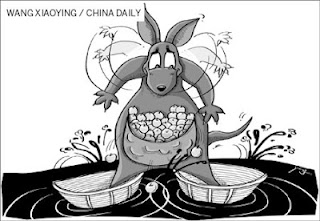 When Julia Gillard replaced Kevin Rudd as Prime Minister in
the midst of the campaign by mining monopolies to prevent the Resources Super
Profits Tax, she announced that she had opened the door to the mining industry.
When Julia Gillard replaced Kevin Rudd as Prime Minister in
the midst of the campaign by mining monopolies to prevent the Resources Super
Profits Tax, she announced that she had opened the door to the mining industry.
The RSPT was abandoned and a watered-down Mineral Resource
Rent Tax was substituted.
The RSPT was to
be levied at 40% and applied to all extractive industry including gold, nickel
and uranium mining as well as sand and quarrying activities. The MRRT will be levied on 30% of the super
profits from the mining of iron ore and coal only, and the mining company will
only have to pay the tax when its annual profits reach $75 million. The MRRT is proposed to be introduced from 1
July 2012.
Enterprise migration agreements a product of unplanned capitalism
Having
capitulated to the big miners on the RSPT, the Gillard government has now
capitulated to their demand to import foreign workers, with Immigration
Minister Chris Bowen granting the world’s richest woman, Gina Reinhart an “enterprise
migration agreement” that will see some 1700 workers, or 21% of the workforce,
brought in to her $9.5 billion
Roy Hill project in Western Australia.
This is a disgrace.
It is an indictment of capitalism.
Capitalism can operate individual workplaces that are strictly
regulated by the boss and run to exacting plans designed to maximise the
individual capitalist’s realisation of surplus value, or proft.
But the economy as a whole defies planning and regulation. Capital flows globally in search of the
quickest means of making a profit, leaving governments scrabbling to devise
ever-newer “incentives” to attract capital into less profitable but socially
useful areas.
If we could really regulate and plan under capitalism we
would long ago have had an even stronger RSPT in place and it would have
funded the establishment of a Mining Industry Skills Institute where trainees
on a living wage learned the skills required in mining and thereby obviated the
need to bring in foreign workers to meet a “skills shortage”.
The MISI would have enabled those who had lost jobs in manufacturing,
as well as youths fresh out of school, to transition into new areas on
employment in the extractive industries.
But no, just as we send raw materials out of the country for
others to value-add, so we send unemployed manufacturing workers and too many
of our young people onto the scrapheap of unemployment.
The mining industry runs its self-congratulatory propaganda
about being a creator of jobs. In fact,
it will increasingly turn to technology to destroy jobs in its sector, such as
the introduction of driverless trucks and driverless trains.
And if it is not destroying jobs, it will replace them by
importing workers trained at another society’s expense and ready to be returned
to it when they are no longer needed.
Gillard has no excuses
Gillard has offered the weak excuse that she knew nothing of
the enterprise migration agreement approved for Rinehart.
If that is true, then she is too busy sucking up to US
imperialism and NATO to know what is happening in her own backyard.
This is not some minor announcement: it is the first-ever
enterprise migration agreement and one that was always going to embroil the
government in controversy.
ACTU secretary Dave Oliver said that home workers had been
"overlooked" and called on Ms Gillard to intervene in the situation
immediately.
"We think it’s a reprehensible situation," Mr
Oliver said.
Outspoken MP Bob Katter also faulted the Government's move,
branding it a ludicrous decision which erodes confidence in the national
economy.
"These people are so lacking in patriotism and so
committed to looking after the interests of corporations that invariably are
foreign owned or foreign financed, that they have agreed to fly in people from
overseas," Mr Katter said.
"They will undermine our awards and they will take your
jobs, and I don't just mean in mining - it'll spread beyond that.
"The Australian people will not stand for this."
CFMEU
Construction National Secretary, Dave Noonan said that this decision was a
disgrace, as the company had not been required to try and employ local workers
before being granted the EMA.
“Today’s decision
is disgraceful and unnecessary. At a time of high youth unemployment in many
parts of Perth and Western Australia, job losses in the non-mining states, and
declining construction employment, Immigration Minister Chris Bowen has written
a blank cheque to Australia’s richest woman.
“Instead of
standing up for Australian workers and requiring her to advertise these positions
or train workers for them, Chris Bowen has fallen over himself to help Gina
Rinehart bring in cheap bonded overseas labour,” Mr. Noonan said.
Mr. Noonan said
that the new agreement will mean that at least 21% of the total construction
workforce for this project will be temporary foreign labour.
“Apart from the
impact on local workers, the CFMEU is also very concerned that these workers
owe their temporary visas to their employer, and are under constant threat of
deportation if they stand up for their rights or complain about dangerous
conditions,” Mr. Noonan said.
Demand the
Resources Super Profit Tax be brought back!
Make the rich pay
every inch of the way!
Take away the
power of the ruling class and run the country ourselves!
For national
independence and socialism!




